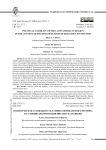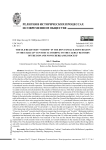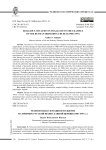Религия в исторических процессах и современном обществе. Рубрика в журнале - Вестник ВолГУ. Серия: История. Регионоведение. Международные отношения

Статья научная
Introduction. The research topicality is determined by the necessity of interior political proving of regions stable development in the conditions of religion institute politicization in 20th - 21st centuries. The purpose of the work is to analyze the influence of the confessional factor on the domestic political process in the Latin American region in the context of global trends of our time. Methods. The work uses methods of theoretical and applied political science analysis, methods of forecasting and modeling. The methodological basis of the work was the principles of systemic and constructivist approaches. Analysis. In the result of political science analysis of stable social and political issues development questions the explicative model of religion institute politicization processes influence to the sustainability of the Latin American region was offered. The theoretical importance of the research is in the reasons and tendenciesrevealing ofreligion institute politicization in the Latin American region. The practical importance of research is determined by the possibility of recommendation output of interior political support of the Latin American region in the conditions of social and cultural uncertainty. Authors’ contribution. E.V. Efanova - the concept of the study, collection and processing of materials; E.M. Drinova - research methodology, writing of the main text; N.Yu. Veremeev - analysis and translation of foreign sources.
Бесплатно

Статья научная
Introduction. This article represents an analysis of the state of the Old Believers’ “schism” in the Don Cossack Host Region (Province or Oblast ) in the early 20th century: determining the Old Believers’ concords existing in the region, as well as their numbers and localization. Methods and materials. The empirical base of this article consists of a complex of archival documents, the clergy records, which represent the clerical documentation of the churches of the Don and Novocherkassk Diocese of the Russian Orthodox Church. The member churches, as well as the numbers of the Old Believers and their belonging to different concords, were recorded in those documents on an annual basis. This is the first time that the statistical component of the complex of those sources is introduced into the scientific operation. The methodological base of this article is represented by the principles of scientific objectivism and systematicity, which are traditional for historical science. Based on those principles, we could reveal and correctly determine the complex of historical sources, while their systematic study provided the opportunity to make conclusions on the state of the Old Believers’ community of the Don Region in the early 20th century, to reveal the Old Believers’ concords (persuasions), which were popular in the Don Cossack Host Region in the period under examination, and to determine their localization peculiarities). Analysis and results. As a result of the analysis, it was found out that in the territory of the Don Cossack Host Region there lived representatives of both concords: those who recognized the hierarchy (“ Popovtsy ”, i.e. priesthood followers) and those who did not (“ Bespopovtsy ”, i.e. not following priesthood). The former were represented by “ Beglopopovtsy ”, i.e. fugitive priesthood followers, and the Austrian (Belaya Krinitsa) concord, with the latter divided into “ Okruzhniki ”, i.e. followers of the 1862 Epistle, and “ Neokruzhniki ”, i.e. those who did not recognize it. The “ Bespopovtsy ”, along with a large group whose membership was not provided, were divided into “ Pomortsy ” (coastal church followers), “ Pomortsy-Brachniki ” (coastal church followers recognizing the marriage), and “ Sredniki ” (Wednesday tradition followers. As compared to the results of the First General Census of the Russian Empire, the Old Believers’ population had decreased in the region, still comprising more than 5% of the total number of the local residents. The major part of the Old Believers was localized in the First and the Second Don Okrugs (districts). Most representatives of all concords lived in the Cossack yurt (small settlement) in the stanitsa (Cossack village) of Nizhny Chir. The characteristic feature of the Old Believers of the Don Region was their conflict-free living side by side with representatives of the Russian Orthodox Church, with co-believers, and with those following different concords.
Бесплатно

Религиозная ситуация в Тольятти на примере Русской Православной Церкви (1988-1997 гг.)
Статья научная
В статье исследуется религиозная ситуация и деятельность православных религиозных организаций, а также изменение государственно-церковных отношений в 1988-1997 гг. в г. Тольятти. Проанализировано соотношение официальной религиозной политики с конкретным ее воплощением на местах. Цель статьи - исследовать характер и оценить результаты государственно-церковных отношений в Тольятти после принятия в 1988 г. нового Устава РПЦ, а в 1990 г. Закона СССР «О свободе совести и религиозных организациях». В работе использованы материалы центрального государственного архива Самарской области, муниципального казенного учреждения «Тольяттинский архив», текущего архива Самарского епархиального управления, периодическая печать рассматриваемого периода, материалы личного архива автора: переписка духовенства с должностными лицами Тольятти и Самарской области, отчеты чиновников как светских, так и церковных о религиозной обстановке в Самарской области и г. Тольятти, протоколы собраний Ставропольского благочиния, проекты документов и сами документы, другие официальные и неофициальные материалы, которые в силу своей специфики не попадают ни в церковные, ни в светские архивы. Методология исследования включает метод анализа документов, в работе с материалами периодической печати был применен метод синхронного сопоставления с документальным материалом. В статье утверждается, что несмотря на формальное отделение от государства религиозных организаций, РПЦ, были предоставлены преференции в виде прямого бюджетного финансирования церковного храмостроительства, привлечения с помощью государственных институтов средств спонсоров на то же храмостроительство, создание с участием государственных и муниципальных структур совместно с РПЦ благотворительных фондов в центре и на местах.
Бесплатно

